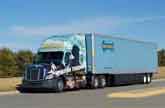| |
|
| |
|
 |
Supply
Chain by the Numbers |
| |
|
| |
- April 23, 2015 -
|
| |
|
| |
|
| |
|
| |
Caterpillar Predicts 2015 Global GDP Growth; Are Printable RFID Tags Finally Coming? Werner Says Length of Haul Declining; Union Pacific Keeps Profit Margins High |
| |
|
| |
| |
| |
|
500+
|
|
The average length of haul has fallen to a little over 500 miles, from 700-800 a few years ago at truckload carrier Werner. That according to company president Derek Leathers last week at an executive panel discussion at the NASSTRAC annual conference last week in Orlando. The trend is being driver by shippers interested in positioning inventory closer to customers, especially in the eCommerce arena. This trend has many implications, including the return a carrier gets on its investment in a truck, how much a driver is paid on a daily basis, and more, so this is a big deal.
|
| |
| |
|
| |
| |
20.5% |

|
That was rail carrier Union Pacific net income as a percent of revenues in Q1, the company recently announced in its Q1 earnings report. That is an impressive number, far higher than most companies can achieve, and coming even in a somewhat lackluster Q1 environment, where volumes were down 2%. By way or comparison, Procter & Gamble profit was equal to just 11.8% in the latest quarter. It wasn't that many years ago that the rail industry struggled to make profits. Union Pacific by the way was able to improve its operating ratio - operating expense divided by operating revenue - down to 64.8%, a decrease of 2.3 percentage points from Q1 2014.
|
| |
| |
|
|
|
| |
 |
 |
| |
|
|
| |